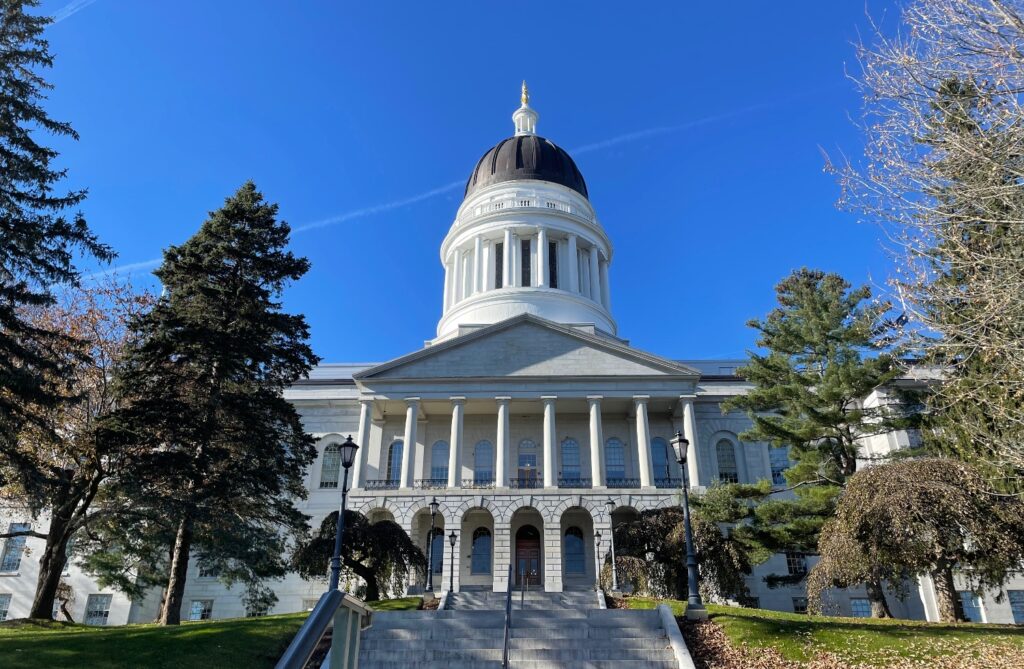The Maine State House in Augusta. (Maine Morning Star)
New budget projections released by the Department of Administrative and Financial Affairs show Maine facing a $951 million gap between expected revenues and expenses in the 2026-2027 biennium. Of this shortfall, just under $638 million is in general fund revenue and spending, while the highway fund shortfall is just under $313 million.
A look at past projections reveals sizeable budget shortfalls are nothing new. For example, the projections for the 2014-2015 biennium — which came on the heels of Republican control of the governor’s mansion and legislature — indicated a $1.1 billion shortfall comprised of $756 million from the general fund and $330 million from the highway fund. Not only was this projected shortfall greater than the one for the coming biennium, but as a percentage of the budget at the time, it was twice as large (12%) as the current sum (6%).
Projected biennial budget shortfalls greater than hundreds of millions are the norm and should not be misrepresented to score political points. Ultimately, the legislature and governor must work to pass a balance budget based on actual revenues and expenses as they have done historically under Republican, Democratic, and Independent administrations.
Past approaches to closing the deficit should not necessarily be a model for lawmakers. For example, in the 2014-15 biennium, the governor and legislature raised additional revenue by increasing the sales tax from 5% to 5.5% (offset by a credit for Mainers with the lowest income), but most of the gap was closed through cuts or failing to fund statutory obligations. The state’s share of school funding was only 47% instead of the required 55%, teacher retirement obligations were not fully met, and municipal revenue-sharing was underfunded by $167 million over the biennium. The LePage administration also took MaineCare coverage away from tens of thousands of people with low income.
This year’s projections call attention to the need to build a path toward a balanced budget by taking full view of anticipated revenues and expenses and by learning from the failed approaches of the past.
Part of the reason for the large deficit in the current projection is that costs are expected to grow faster than revenues. The primary drivers of the increased costs are programs that have widespread support. Most of the largest increases in spending are in the Department of Health and Human Services and include increased rates for medical providers, higher wages for care workers, payments to nursing homes, and generally increased costs of medical treatment in the Medicaid program. There are also some significant spending increases in the Department of Education, which represent normal cost increases (around 2.5% per year) for the state’s share of K-12 education.
Lawmakers from both parties have recognized the need for additional money in these areas to address workforce shortages and support the most vulnerable Mainers. In the most recent supplemental budget, both parties put forward proposals that increased spending in these areas in the upcoming biennium. The Democratic supplemental budget which ultimately passed had $324 million in new spending in 2026-27, while the Republican proposal included $369 million.
The departments of Education and Health and Human Services together account for 79% of all projected General Fund spending in the 2026-2027 biennium. If lawmakers attempted to close the deficit by cutting spending alone, they would inevitably have to cut aid to school districts, prompting new property tax increases, or take away health care from vulnerable Mainers.
But lawmakers have other tools available. The state’s Budget Stabilization Fund (also known as the “rainy day fund”) is at its statutory maximum of $968 million and is designed to help fill budget gaps when revenues fall short. Lawmakers also stored away additional savings in the Education Stabilization Fund and MaineCare Stabilization Fund to cover extra expenses in those areas. Given the shortfall is driven by ongoing spending needs, it would not be advisable to rely completely on these rainy day funds, but it could help cover some expenses in the short term.
The sustainable solution to this deficit must come from raising revenues. As Maine Center for Economic Policy has noted before, general fund revenues are still around $900 million a year lower as a result of the LePage-era tax cuts which primarily benefitted the wealthy. A combination of tax increases which focus on the highest-earning Mainers and large corporations could raise $275 million each year, and fill almost all of the structural deficit in the general fund.
The Highway Fund’s structural issues are longstanding and largely driven by the legislature’s decision to freeze the fuel tax back in 2011 instead of increasing it with the cost of doing business. As wages for construction workers and the cost of materials have increased each year, fuel tax revenues have been artificially depressed. If fuel tax was updated to reflect inflation (to 44 cents per gallon in 2026 and 45 cents per gallon in 2027), the highway fund would have an additional $230 million over the biennium, closing three quarters of the deficit in this fund.
For years, lawmakers have avoided raising significant amounts of revenue, even as they have recognized that Mainers are facing acute needs. That procrastination is now catching up with them. The next legislative session will require lawmakers to finally ask the wealthiest Mainers to pay their fair share for the widely supported programs critical to our collective wellbeing.
A new revenue forecast published in December could increase or decrease the size of projected shortfalls but is unlikely to change the bottom-line figure substantially before the start of the 132nd legislature. To close the gap, raising revenue must be part of the solution.
This piece was originally published by the Maine Center for Economic Policy blog.
YOU MAKE OUR WORK POSSIBLE.

